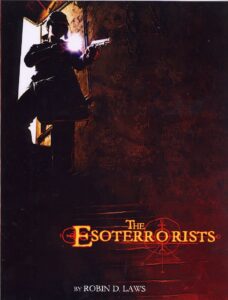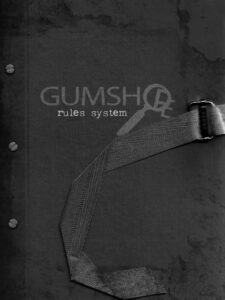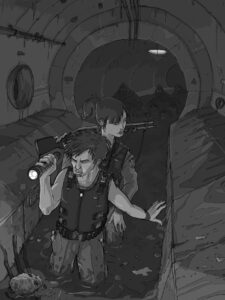Beyond the edge of our senses lies nothing but madness and doom, a Possibility so terrifying that if unleashed would destroy not only our humanity but with it, all Reality. This is the Outer Dark, a source of ultimate power, and unforgiving terror, which at in the same instant calls to those who would but listen, and consumes those who cannot turn away. This is the world of the Esoterrorists.
 The Esoterrorists (1st Edition) is a simple and compact roleplaying game that successfully ushered in the GUMSHOE system. Written by Robin D. Laws and published by Pelgrane Press in 2006, it is a perfect example of both the strengths and limitations of what was to become a paradigm challenging game. As such, in this review I’m going to briefly break down the good, the bad and the ugly of The Esoterrorists and the system that would lead the way to numerous other GUMSHOE games, as well as a much expanded second edition in 2013.
The Esoterrorists (1st Edition) is a simple and compact roleplaying game that successfully ushered in the GUMSHOE system. Written by Robin D. Laws and published by Pelgrane Press in 2006, it is a perfect example of both the strengths and limitations of what was to become a paradigm challenging game. As such, in this review I’m going to briefly break down the good, the bad and the ugly of The Esoterrorists and the system that would lead the way to numerous other GUMSHOE games, as well as a much expanded second edition in 2013.
For those unfamiliar with the GUMSHOE system, it arose from the author’s issue with roleplaying games where luck impacted the progression of a scenario’s core story-line or investigation (such as occurs when players need to roll skill checks to find leads or clues). Robin, from what I’ve read, wanted to have a simple system that allowed for competent characters to always find these important clues, and move the focus on to how the players interpreted them, rather than if they find them at all. I’ve seen and listened to arguments on both side of the fence on this underlying issue (and whether such mechanics resolve such problems, or simply create others), but from my experience the GUMSHOE system does achieve everything it was set out to do. The other side of the mechanics, that of general skill checks or combat, is a very straight forward D6 mechanic, which is easy to teach and does its best to get out of the way of the roleplaying.
Note this reviews was originally written for and published at rpggeek.com, and appears here for completionism reasons.
 In The Esoterrorists, the players take on the role as agents of Ordo Veritatis, a vast secret organisation dedicated to stopping the namesake esoterrorists from unleashing the Outer Dark, into our reality. In some ways the core premise is much like that of its older, more venerable cousins – Call of Cthulhu, Delta Green or even The Laundry – however, these characters are not some innocent, unsuspecting investigators, but rather they’re elite individuals, who through their will, wits and strength of arms must become Realities Last Defenders.
In The Esoterrorists, the players take on the role as agents of Ordo Veritatis, a vast secret organisation dedicated to stopping the namesake esoterrorists from unleashing the Outer Dark, into our reality. In some ways the core premise is much like that of its older, more venerable cousins – Call of Cthulhu, Delta Green or even The Laundry – however, these characters are not some innocent, unsuspecting investigators, but rather they’re elite individuals, who through their will, wits and strength of arms must become Realities Last Defenders.
Of all the GUMSHOE games to be released (which by my count is nine different settings to date), The Esoterrorists is by far the simplest and most straightforward. The book itself is only 90 pages in length, and while it is short on setting material (having only a page and half on the Ordo Veritatis for example), it does includes everything you need to play (bar a few pencils and a D6 or two). It has a nice thematic cover and is nicely laid out – although I personally feel the page borders are a little too ‘busy’ for my liking, and the header font – while readable – is a little too distorted in style.
The good and positive aspects of the book are many-fold, and Robin never wastes too much time explaining roleplaying basics to the reader. It’s very much a matter of – here’s the setting, the rules, and a few examples of what you can do – now have at it. I appreciate this succinctness (with the caveats mentioned earlier), as in no way is this game expected to be a player’s gateway to roleplaying. Outside the rules – which would be improved with every generation of GUMSHOE – I think the simple concepts of the Membrane – the barrier between the separate realms of objective and subjective reality that is weakened by humanity’s belief in the supernatural – is a fascinating idea. As is the component of the characters having to complete a ‘Veil-Out’, i.e. covering up the supernatural event or entity after its defeat, to reduce public anxiety on about the possibility of reality not being as stable as we all believe.
 On the down side, the art, outside of the cover, is sparse and limited (the one-page comic is redundant and a waste of space in my opinion), and the introductory scenario – Operation Slaughterhouse – is nothing to write home about; noting its excessive gore and straight forward plotting. I will say than neither of these degrade the game in any way, but neither do they really do anything to highlight the genuinely good or great aspects of GUMSHOE or The Esoterrorists.
On the down side, the art, outside of the cover, is sparse and limited (the one-page comic is redundant and a waste of space in my opinion), and the introductory scenario – Operation Slaughterhouse – is nothing to write home about; noting its excessive gore and straight forward plotting. I will say than neither of these degrade the game in any way, but neither do they really do anything to highlight the genuinely good or great aspects of GUMSHOE or The Esoterrorists.
All in all, The Esoterrorists really seems like some sort of demo or experimental game, and I suppose in some ways it was. It presented a new way of gaming utilising a setting that had a good following – modern horror – and focused on what made it different. Today, getting a copy of 1st edition The Esoterrorists isn’t too difficult, although the PDF is no longer available via the usual online game stores.
As a final note, yes, I am aware that a number of excellent supplements and scenarios have been released for the game – and the second edition goes a fair way to address some of this first edition’s limitation – but as I am hoping that this brief review is the start of a journey to explore the entirety of The Esoterrorists releases, each of these will get its own spotlight sometime in the future.


Leave a Reply